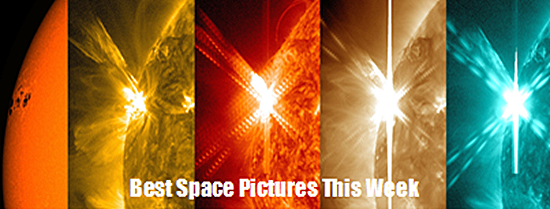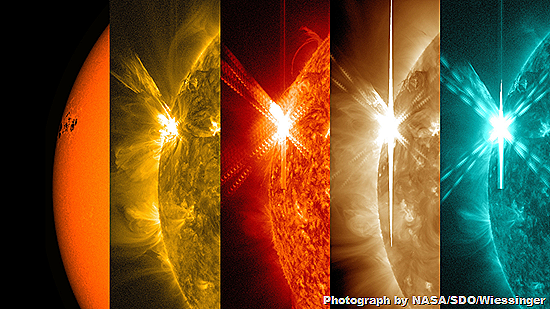
Week's Best Space Pictures: The Sun Flares For Cinco de Mayo
By Jane J. Lee, National Geographic News, 8 May 2015.
By Jane J. Lee, National Geographic News, 8 May 2015.
Feed your need for "heavenly" views of the universe every Friday with our picks for the most awe-inspiring space pictures. This week, the sun throws a tantrum, a tilted galaxy confounds scientists, and a 3-D picture of Ceres hurts the eye.
1. A Flash of Light
The sun put on a Cinco de Mayo show by firing off an intense flare on May 5. NASA's Solar Dynamics Observatory caught the burst of radiation in visible light (far left) and in several wavelengths of extreme ultraviolet light.
2. A Slanted View
This topsy-turvy galaxy is NGC 949, located over 30 million light years away from Earth. Its tilted orientation makes it hard for researchers to determine the galaxy's exact shape, although they're fairly certain it's some kind of disk galaxy.
3. Reach For The Sky
Japanese astronaut Kimiya Yui powers through a second day of qualifying exams with two other candidates at the Gagarin Cosmonaut Training Centre in Russia. All three are headed to the International Space Station this May.
4. Ceres in 3-D
No, your screen isn't broken: This offset image is an anaglyph, or 3-D rendering, of the dwarf planet Ceres. Situated between Mars and Jupiter, Ceres has drawn scientific interest because of signs it may contain a lot of water ice beneath its surface.
5. Muddy Waters
Madagascar's Tsiribihina river delta (top) is awash in mud in an image taken by an astronaut on-board the International Space Station. Heavy rains washed dirt and soil into the river, which eventually funnelled its load into the ocean (bottom).
6. Mini Mimas
An 80-mile-wide (130-kilometre) impact crater inspired the nickname "Death Star" for one of Saturn's 52 moons, Mimas (top left). A second Saturnian moon, Atlas, is barely visible outside the planet's main rings (thick bands at bottom right).






No comments:
Post a Comment
Please adhere to proper blog etiquette when posting your comments. This blog owner will exercise his absolution discretion in allowing or rejecting any comments that are deemed seditious, defamatory, libelous, racist, vulgar, insulting, and other remarks that exhibit similar characteristics. If you insist on using anonymous comments, please write your name or other IDs at the end of your message.